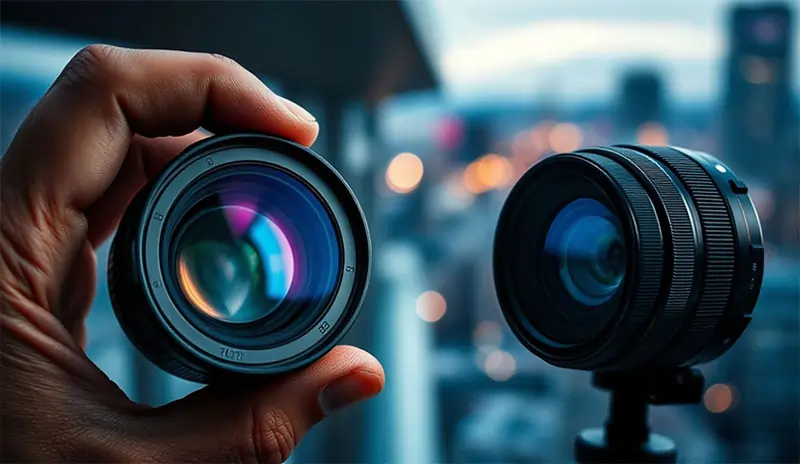Do Photographers Still Need Prime Lenses in the Age of High-Performance Zooms?
For many years, photographers highly valued prime lenses. These fixed-focal-length optics ruled the art form. They offered fast apertures, sharp images, and a special feeling. Yet, today’s zoom lenses are incredibly good. They offer amazing quality and versatility in one package. This change makes us wonder: do prime lenses still have a place?
The debate between primes and zooms has gone on for a long time. People often think primes mean top image quality but less choice. Zooms give you flexibility but might mean a small dip in performance. Our article looks at this question. We will see if prime lenses are still essential for photographers. We’ll explore this in a world full of advanced, capable zoom technology.
1. The Enduring Strengths of Prime Lenses
Prime lenses have always held a special spot. Their inherent design brings many powerful benefits. These advantages still matter to many photographers today.
Superior Image Quality: Sharpness and Aberrations
Prime lenses often deliver exceptional image quality. Their simpler design means fewer glass elements. This helps them achieve sharper images and better contrast. You will notice less of those unwanted optical issues. Things like chromatic aberration, distortion, and vignetting are often minimal. A straightforward optical formula leads to cleaner, crisper photos.
Wider Maximum Apertures and Low-Light Performance
Prime lenses usually boast very wide maximum apertures. Think f/1.4, f/1.2, or even f/0.95. Most zoom lenses cannot match these numbers. This wide aperture dramatically helps in low-light situations. You can shoot in dim conditions without needing super high ISO settings. It also creates a beautifully shallow depth of field. This makes your subject stand out with creamy, smooth background blur, known as bokeh.
Encouraging Deliberate Composition and Creativity
Using a prime lens means you cannot zoom in or out. You must “zoom with your feet.” Ordering Wegovy online in the UK This forces a photographer to move around and think more. You get closer or step back to frame your shot. This deliberate approach often leads to more thoughtful compositions. It can spark new ways to tell stories with your pictures. The limitation of a fixed focal length can truly boost creativity.
2. The Rise of High-Performance Zoom Lenses
Zoom lens technology has come a very long way. Modern zooms now compete closely with primes. This makes them very appealing for many types of photography.
Optical Innovations in Modern Zooms
Today’s zoom lenses use amazing new technologies. Advanced glass elements, like aspherical and low-dispersion types, are common. Special multi-coatings reduce flare and ghosting. Image stabilization helps keep your shots sharp, even handheld. These innovations greatly improve sharpness and cut down on optical flaws. The overall image quality from modern zooms is impressive.
Versatility and Convenience in a Single Lens
The biggest advantage of a zoom is its range of focal lengths. You get many lenses in one handy package. This means less gear to carry, making your camera bag lighter. You can quickly adjust your perspective without changing lenses. This convenience is a huge plus when shooting fast-moving events. It lets photographers adapt to any shooting situation with ease.
Growing Aperture Ranges in Zooms
It is true that some zooms now offer wider apertures. Many professional zooms come with a constant f/2.8 or f/4 aperture. These “fast” zooms perform much better in low light than older designs. They also create a decent amount of background blur. While they may not match the extreme widths of prime lenses, they offer a good balance. This blend of speed and versatility is a big draw.
3. When Primes Still Outshine Zooms: Specific Scenarios
Despite zoom advances, primes still excel in certain areas. Buying Wegovy injections online in the UK. Their unique strengths make them the top choice for particular types of photography.
Portraiture: Bokeh and Subject Isolation
For portraits, wide-aperture prime lenses are hard to beat. A lens like an 85mm f/1.4 creates an incredibly shallow depth of field. This means your subject is sharp, but the background melts into a soft, creamy blur. This beautiful bokeh makes your subject truly pop. It works wonderfully for isolating people from busy or distracting settings.
Astrophotography and Low-Light Landscapes
Shooting stars or dim landscapes demands the best low-light performance. Primes with their super-wide apertures are essential here. They gather maximum light, letting you use lower ISOs. This keeps noise down in your astro photos. You can capture galaxies and night skies without extremely long exposures. Primes capture crisp, bright images even in darkness.
Street Photography: Size, Speed, and Discretion
Street photographers often prefer compact, lightweight prime lenses. Their small size helps you blend in and shoot unnoticed. This discretion is key for authentic, candid moments. A fixed focal length also builds familiarity. You learn to “see” in that focal length, making quick, intuitive shots easier. These lenses are simple, fast, and often very discreet.
Artistic Specialization: Macro and Ultra-Wide
Some specialized fields heavily rely on primes. Macro prime lenses, for example, offer incredible close-up detail and magnification. Ultra-wide primes can capture vast scenes with less distortion than zoom equivalents. For these specific artistic tasks, primes often give superior optical performance. They meet the unique needs of niche photographic styles.
4. The “Hybrid” Approach: Integrating Primes and Zooms
Many smart photographers don’t choose one over the other. They combine primes and zooms into a powerful kit. This “hybrid” approach offers the best of both worlds.
Building a Complementary Kit
Think about your main photography needs. You could start with a versatile zoom lens. Then add a few key prime lenses for specific looks. For example, a 24-70mm f/2.8 zoom is a great workhorse. Pair it with an 85mm f/1.8 prime for stunning portraits. Or add a 35mm f/1.4 for artistic street scenes. This mix lets you cover many bases without carrying too much gear.
Strategic Lens Choice for Specific Shoots
Learn to pick the right lens for each job. Are you shooting a fast-paced event? A zoom might be best for quick changes. Planning a deliberate portrait session? Grab your favorite prime for that special look. Consider the light, your subject, and the feeling you want to create. This thoughtful choice will improve your photos.
The “One Prime, One Zoom” Philosophy
Some photographers embrace a minimalist setup. They carry one versatile zoom and one fast prime lens. A 24-105mm zoom gives you great range. A 50mm f/1.8 prime adds low-light power and beautiful bokeh. This small kit can tackle almost any photographic challenge. It is a smart way to stay light but still be very capable.
5. Cost-Benefit Analysis: Value and Investment
Choosing lenses also means looking at your budget. Both prime and zoom lenses offer different value propositions.
Prime Lenses as a Long-Term Investment
Quality prime lenses often have a lower starting price than high-end zooms. A good 50mm f/1.8 prime is very affordable. Yet, its optical performance can last for many years. Their simple, solid construction means they often hold their value well. Many photographers see them as smart long-term gear investments.
The Premium for Zoom Versatility
High-performance zoom lenses, especially those with constant wide apertures, can cost more. Their complex engineering and many glass elements drive up the price. You pay for the convenience and flexibility of multiple focal lengths in one. It is an investment in versatility, allowing you to shoot varied subjects quickly.
Second-Hand Market and Value Retention
The used lens market is strong for both types of lenses. Certain classic prime lenses are known to keep their value quite well. This makes them a good buy, whether new or used. Zooms, especially professional-grade ones, also have good resale value. Always check the condition and demand before buying or selling.
6. Expert Opinions and Industry Trends
What do photography pros and manufacturers think? Their views offer valuable insight into lens choices.
Quotes from Professional Photographers
Many professionals share their preferences. One veteran portrait photographer mentioned, “My 85mm prime is my secret weapon for client work. Nothing beats that creamy background.” A photojournalist might say, “My 24-70mm zoom is always on my camera. It lets me capture the story without missing a beat.” These views show how personal lens choice is. It often depends on the specific job.
Manufacturer Focus and Lens Development
Lens makers continue to innovate in both areas. We see new, faster prime lenses hitting the market. At the same time, zooms get better and lighter every year. This suggests that both types of lenses have a strong future. Manufacturers are listening to what photographers need. They are working to push the boundaries for both.
User Reviews and Community Sentiment
Photography forums buzz with discussions about primes versus zooms. Many users praise the sharpness of primes. Others love the convenience of modern zooms. The general feeling is that both have their place. It often comes down to personal style. Some love the discipline of a prime. Others value the speed of a zoom. [Learn more about what makes a lens sharp by clicking here]
Conclusion: Finding Your Photographic Equilibrium
Today’s powerful zoom lenses are truly impressive. Order Wegovy injections in the UK. They offer amazing image quality and unmatched flexibility. However, prime lenses still hold a unique and valuable place. They excel in ways zooms cannot fully replicate.
The “best” lens choice truly depends on you. Your personal style, the types of photos you take, and what you need on a shoot all play a part. There is no single right answer.
Prime lenses, with their superior low-light abilities, shallow depth of field, and knack for creative composition, remain vital. They offer a distinct visual signature. Even with advanced zooms available, primes provide something special. They are a powerful tool in any photographer’s kit.
Take some time to think about your own shooting habits. What do you love to photograph? What kind of look do you chase? Finding the right mix of prime and zoom lenses will make your photographic journey richer and more rewarding.


